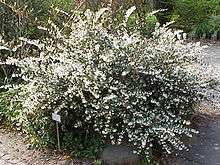Osmanthus delavayi
| Osmanthus delavayi | |
|---|---|
 | |
| Scientific classification | |
| Kingdom: | Plantae |
| (unranked): | Angiosperms |
| (unranked): | Eudicots |
| (unranked): | Asterids |
| Order: | Lamiales |
| Family: | Oleaceae |
| Genus: | Osmanthus |
| Species: | O. delavayi |
| Binomial name | |
| Osmanthus delavayi Franch. | |
| Synonyms[1] | |
| |
Osmanthus delavayi is an evergreen shrub of the genus Osmanthus native to the Guizhou, Sichuan and Yunnan regions of southern China and cultivated as an ornamental elsewhere.[2]
Osmanthus delavayi was discovered by the Jesuit missionary-botanist Fr Pierre Jean Marie Delavay in the mountains near Lan-kong in Yunnan province, China, in 1890. He sent seed to the French nurseryman Vilmorin. Though Maurice de Vilmorin distributed the seed among various correspondents, only a single seed germinated. All the O. delavayi of European gardens were cloned from this one source, until George Forrest obtained further supplies of seed in China after World War I.[3][4]
Over several weeks in late winter to spring, Osmanthus delavayi bears fragrant flowers that are more prominent but less fragrant than Osmanthus fragrans, but substitutes for O. fragrans in less balmy gardens. The shrub received an Award of Garden Merit from the Royal Horticultural Society in 1923 and has been praised by British garden writers. It is a garden staple in the east coast of Australia as far south as Tasmania.[5] Its USDA Zone range is 7-9 (it can survive -15C), making it hardy in sheltered locations as far north as coastal New York and in the Pacific Northwest.
| Wikimedia Commons has media related to Osmanthus delavayi. |
Notes
- ↑ "The Plant List".
- ↑ Kew World Checklist of Selected Plant Families, Osmanthus delavayi
- ↑ Alice M. Coats, Garden Shrubs and Their Histories (1964) 1992, s.v. "Osmanthus".
- ↑ Franchet, Adrien René. 1886. Bulletin Mensuel de la Société Linnéenne de Paris 1(77): 613–614 Osmanthus delavayi
- ↑ Don Burke, The Complete Burke's Backyard: the ultimate book of fact sheets, s.v. "Osmanthus delavayi".